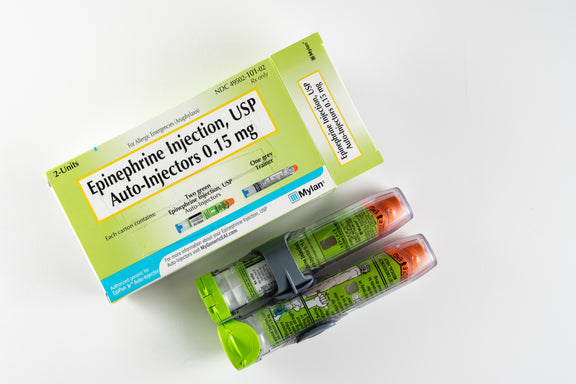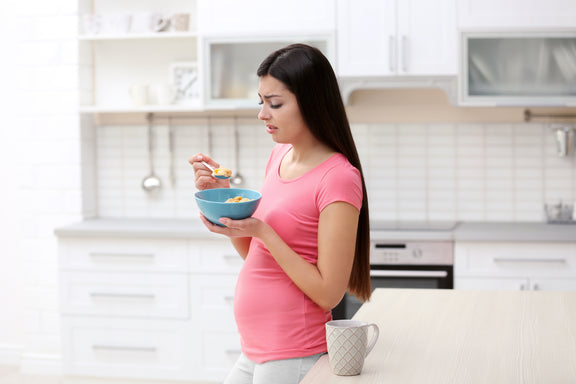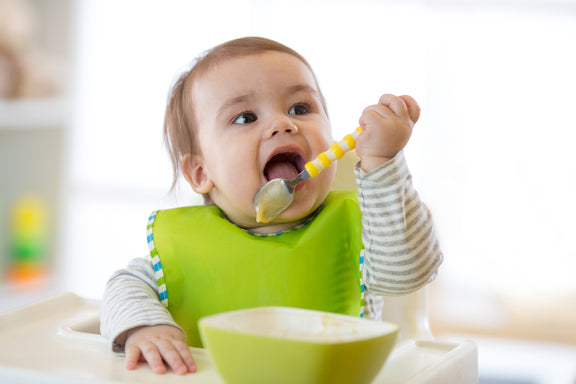When is the right time to introduce your baby to solids, and what rules should you follow to make the process safer and easier? Find out in this article.
Introducing solids can be an exciting time for parent and child. It’s also an important developmental opportunity for baby. Here are some rules to follow to help embrace this new milestone and enjoy your baby’s first foods together as a family!
1. Follow Your Baby’s Cues, Not the Calendar
According to the American Academy of Pediatrics (AAP), the following are important cues to recognize when your baby is ready for introducing solids:
- Sitting up with minimal support
- Achieving strong head control, i.e. can hold head up for an extended period of time
- Showing interest in food, i.e. trying to grab food off your plate
- Turning head away from the bottle or breast when not hungry
While 6 months of age is the recommended age to start solids, it’s more important to know when your baby is ready through their cues to ensure a successful introduction to solids.
2. Maintain Breastfeeding or Bottlefeeding
Breastmilk or formula should continue to be your child’s primary nutrition source for the first year of life. Solid foods should simply supplement (not replace) your already established breastfeeding or bottle feeding practices.
3. Introduce Slowly
The AAP recommends waiting 2-3 days after introducing a new food in case of a possible allergic reaction. Take your time with introducing new foods and always monitor baby for 2-3 hours after introducing a new food.
4. Diversity is Key
Exposing your child to a variety of foods, textures, and tastes is key to ensuring healthy nutrition in the first year of life and beyond. Be adventurous and introduce a wide diversity of fruits and vegetables to keep your child engaged and enjoying their first foods.
5. Foster Self-Feeding
Introducing finger foods and encouraging baby led weaning is a great way to foster independence and help your child develop their fine motor skills. Many parents skip the puree and spoon-feeding phase and let their child grasp finger foods and feed themselves.
6. Avoid Choking Hazards
The AAP recommends that you should avoid giving your baby foods that are larger than a ½ inch in size so make sure to cut up any foods like grapes or cherry tomatoes. Also avoid other choking hazards such as: raw vegetables (cooked, soft vegetables chopped in small pieces are safer) or nut butters.
7. Early Allergen Introduction
New guidelines and landmark research food allergies now recommend introducing allergenic foods at 4-6 months of age.
8. Embrace the Mess and Have Fun!
It’s totally normal for baby to make a mess when introducing solids. It will take a lot of practice and coordination for your child to self-feed properly and predictably. Get used to messes at mealtime and try to embrace introducing solids as a new, sensory adventure for you and your child!

Pros And Cons Of Sippy Cups
Thinking about giving your little one a sippy cup? Today, we’ll co...

What Toddlers Eat In A Day: 12-18 Months Old
Looking for ideas of what to feed your 12-18 month old little one? ...

New Study Shows That Infant Anaphylaxis Usually Resolves With One Epinephrine Dose
A recent study has shown that, when infants experience severe aller...

Pregnancy Nutrition: What To Eat In The First Trimester
What to eat in the first trimester that will nourish your body, pro...

Formula Feeding Amounts: How Much Formula Should You Feed Baby Per Day?
How much formula should baby drink per day? It depends on their age...

What Baby Eats In A Day: 6-12 Months Old
Looking for ideas of what to feed your 6-12 month old little one? H...
All health-related content on this website is for informational purposes only and does not create a doctor-patient relationship. Always seek the advice of your own pediatrician in connection with any questions regarding your baby’s health.
These statements have not been evaluated by the Food and Drug Administration. Products are not intended to diagnose, treat, cure or prevent any disease. If your infant has severe eczema, check with your infant’s healthcare provider before feeding foods containing ground peanuts.

